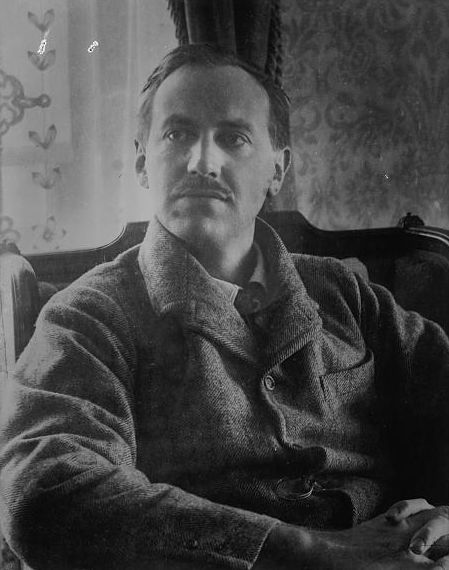Now these are my contributions to the list. These six authors appeared in the same general period and may or may not have provided a significant influence on both Tolkien and Lewis in some cases (MacDonald’s is a bit more eclectic). In some cases, they are unfairly neglected, but they remain important for building the basic groundwork on which nearly all fantasy afterwards contstructed itself.
NOTE: From here on out, all entries discussed have appeared in the Fantasy Authors topic on the Grey Horse Tavern message boards on the main website.
WILLIAM MORRIS (1834-1896)
One of the most well-regarded figures of the Victorian era, a committed socialist in the second half of his life, Morris is known today for his textiles as well as his wallpaper, fabrics and other interior decorations influenced by the Neo-Gothic revival movement. But he was chiefly regarded in his time as a poet and a writer – drawing upon Icelandic sagas, he delivered acclaimed pieces such as The House of the Wolfings, The Roots of the Mountain, The Story of the Glittering Plain, The Wood Beyond the World, The Well at the World’s End, The Water of the Wondrous Isles, and The Sundering Flood; he also dabbled in sci-fi/utopian themes with the novella News from Nowhere. It is reported that Morris is perhaps the greatest influence upon Tolkien in prose style, as he greatly admired these romances and even felt he couldn’t outdo them.
Offsite resources:
William Morris: The Soul of Arts and Crafts
The William Morris Society in the United States
E. R. EDDISON (1882-1945)
A Norse scholar, civil servant and close liaison of the Inklings, Eric Rücker Eddison is remembered, especially by both Tolkien and Lewis, for one of the earliest examples of otherworldly high fantasy – The Worm Ouroboros, a dense epic deliberately constructed in an archaic style reminiscent of Elizabethan drama, Icelandic sagas and Jacobean prose, chronicling the conflict on the planet Mercury (yes, that Mercury) between the nations of Demonland and Witchland. In close relation to this was his ultimately incomplete cycle concerning the world of Zimiamvia: Mistress of Mistresses, A Fish Dinner in Memison, and The Mezentian Gate.
Offsite resources:
The Official E. R. Eddison Website
LORD DUNSANY (1878-1957)
An avid chessman and supporter of animal rights, Edward John Moreton Drax Plunkett, 18th Baron of Dunsany, is one of the earliest worldbuilders, his style influenced by both the King James Bible and his native Irish dialect, among other influences. Long before The Silmarillion was started, Dunsany created a cycle of linked stories concerning the gods and history of Pegâna, as well as other stories of fantasy and horror; even his plays and poetry are tinged with elements of the fantastic. He is also regarded for his novels, chief among them being The King of Elfland’s Daughter, The Blessing of Pan, and The Curse of the Wise Woman.
Offsite resource:
Lord Dunsany: The Potency of Words and the Wonder of Things
Great Science-Fiction and Fantasy Works – Lord Dunsany
JAMES BRANCH CABELL (1879-1958)
Sort of a fantastic contemporary of Mark Twain and H. L. Mencken, Cabell is known primarily for The Biography of the Life of Manuel, a large cycle of novels regarding the imaginary French medieval country of Poictesme and the antiheroic character of Dom Manuel and his descendants. These are definitely fantasy works, but they are also severe satires of the mores and values of his native Virginia and its society. The most famous of his works is Jurgen: A Comedy of Justice, which follows an amorous fool through a fantastically absurd cosmic journey; it only increased in fame after being the subject of an obscenity trial in the 1920s.
Offsite resource:
James Branch Cabell: Overview and Personal Notes
KENNETH MORRIS (1979-1937)
Unrelated to William Morris, this Welsh theosophist is known both for his stories published under several pseudonyms as well as his own name, ranging over a wide spectrum of mythologies, and for his own personal retelling of the First and Third Branches of the Mabinogion over two respective books – The Fates of the Princes of Dyfed and Book of the Three Dragons – as well as an Aztec fantasy, The Chalchihuite Dragon, as well as numerous stories published under several pseudonyms. Aside from being well regarded for his particular prose style, it would seem that he remains a rather enigmatic figure.
Offsite resource:
Theosophical University Press – The Fates of the Princes of Dyfed, Full Text
Theosophical University Press – The Chalchihuite Dragon, Full Text
H. RIDER HAGGARD (1856-1925)
A contemporary of Rudyard Kipling and Robert Louis Stevenson, Haggard is one of the pioneers of the “Lost World” story, mostly the ancient civilizations of newly colonized Africa, and a chief influence on mythopoeia. His most treasured works are the adventure story King Solomon’s Mines, a prototypes of Indiana Jones which has led to quite a few homages, and She, a gothic fantasy highly regarded by Tolkien and Lewis as well as psychologists Freud and Jung. Other works well remembered are Nada the Lily, a historical novel of a Zulu prince and his tragedy in love, and Eric Brighteyes, a Viking epic.
Offsite resource:
Next time, I’ll give a few more that Trae managed to come up with. To directly reach the forum topic this was taken from, go here: http://www.lostpathway.com/tavern/index.php/topic,16.0.html




0 comments